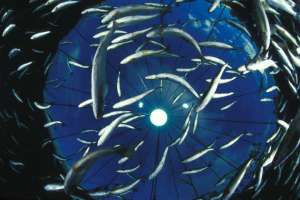
National Geographic
One of the hottest points of debate on aquaculture is the effect that farmed fish might have on their wild cousins. Fish raised in a major aquaculture operation live in close, sometimes cramped conditions that are nothing like the open ocean. As a result, they can become victims of disease and parasites—just as for centuries human beings who lived in densely populated cities tended to fall victim to infectious disease more often than those who lived in sparsely populated rural areas. Disease is a major economic worry for aquaculture producers—just as it is for their counterparts on land–but if infected farmed fish escape, they can introduce those diseases to wild species, with potentially devastating environmental consequences.
But the aquaculture industry has argued that the threat farmed fish might pose to wild ones has been overblown by environmentalist opponents—and last December, fish farmers received a boost from an academic source. Researchers led by Gary Marty—a fish pathologist at the University of California-Davis—found no evidence that the spread of parasitic sea lice from farmed salmon were leading to the dramatic collapse of wild salmon stocks on the West Coast. (There was an amazing 97% decline in wild pink salmon returning to spawn in 2002.) Marty’s results were a departure from other studies that had shown a connection between infections in farmed fish and the decline in wild salmon, but his team was able to analyze new data from industry that hadn’t been available for past research. The study, published in the Proceedings of the National Academy of Sciences (PNAS), concluded that there was no reason to separate farmed fish from wild salmon—a change many environmentalists have long demanded.
More from TIME: The End of the Line
The PNAS study got significant media pickup—at least, as far as fish farming research goes—but it turns out it may be wrong. That’s the conclusion of a new study published today—also in PNAS—that examines some of the same data used in the original study, and finds that parasites like sea lice do indeed hurt wild salmon. Martin Krkosek, a professor in the department of zoology at New Zealand’s University of Otago, led a team of researchers who found that the results of the original study were simply wrong, and understated the impact of lice on wild salmon. By contrast, Krkosek and his colleagues write:
Our results show that survival is negatively correlated with the abundance of lice on salmon farms, for both pink and coho salmon.
Expect more back and forth on this issue, and between these studies. In fact, this week the Canadian government is investigating the possible connections between fish farms and disease in a long-awaited and controversial commission. But both sides have reason to try to fix this problem. Fish farming has environmental costs, but as I wrote in a cover story last month for TIME, we can’t sustainably catch enough wild fish to meet the growing global demand for seafood. The fish of the future will increasingly be farmed—and we need to find and support aquaculture methods that really are sustainable.
Video from TIME: Teach a Man to (Farm) Fish
Bryan Walsh is a senior writer at TIME. Find him on Twitter at @bryanrwalsh. You can also continue the discussion on TIME’s Facebook page and on Twitter at @TIME


